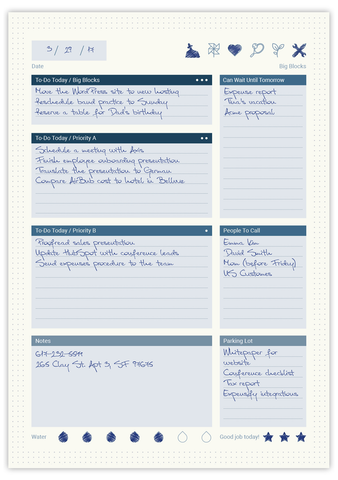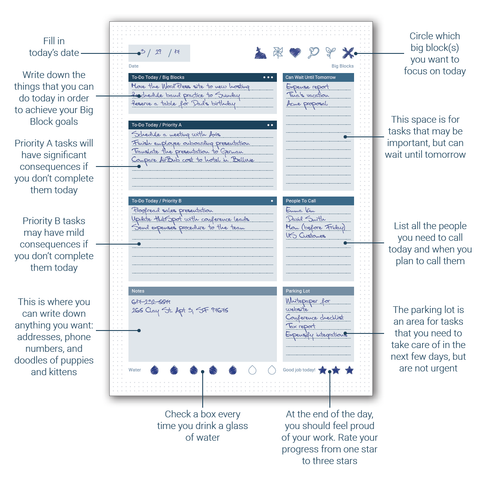I have always been a big fan of planning. Early in my career, I managed large scale projects, which involved people, processes and information systems, sometimes I was required to cross continents and time zones. So, I always used very detailed work plans to manage the timeline and tasks. However, THERE IS such thing as too much detail with work plans, and at some point, regardless of the tool you are using, you will find yourself working for the tool instead of the tool work for you.
So, I decided to break down the various areas of the plans to high-level planning (using software products like MS Project or others with similar functionality) and daily task management checklists (using apps like Keep, Todoist or Trello).
I realized after testing at least ten apps while many applications for task and time management exist, there isn’t one that can replace the added value of sitting down with a pen and paper. It’s just faster, way more convenient, and therefore you will actually use it.
However, I wanted to know what others also thought. I came across a very interesting article on “Popular Science,” written by Amy Schellenbaum, who wrote: “Writing things down can make you feel better, mentally and physically.” Then she added: “…Once you’ve written down all the tiny things you need to get done, you give your brain the capacity and the encouragement to actually do the things.” and concluded: “The manual effort: It’s easy to underestimate the swell of satisfaction from making progress on something physical. To-do lists give nerds like me the thrill of checking something off. It’s a genuinely pleasurable experience.”
David Allen, the productivity guru, shared similar thoughts during a recent Wired.com interview: “A lot of tech people I know are going back to paper because a paper planner … there’s still no better tool than a paper planner.”
After I received reassuring statements, such as the above, I started designing my daily task one-pager.
There were two principles I wanted to follow in developing the tool:
1. I needed the ability to execute daily tasks without losing sight of the bigger picture, so I defined larger, more complex tasks as BIG BLOCKS and made sure that every day the first priority would be to complete a few small tasks that will get me closer to finishing A BIG BLOCK task.
2. I needed to find a way to prioritize, so I defined five priority levels: for today — BIG BLOCKS, A, B. For tomorrow/this week — “Can wait until tomorrow” and “Parking Lot.”
Now, all I needed to do was to act and complete my tasks. See a sample of my daily task manager below.

This is how the daily page looks like when I start my day

All aspects of the daily page explained
After using this system for a while, I could confidently say that for me, it worked better than any productivity app, and this is why:
It’s actually much faster!
I usually have my daily task manager open right next to me. Writing a new task is a one-click action (or two if you count picking up the pen). To do the same in an app, I need:
1. Pick up the phone.
2. Type my password.
3. Find the app.
4. Open the app.
5. Navigate to the task list.
6. Type task.
Paper saved me five clicks.
It prevents distractions.
I assume that your phone, just like mine, is one big distraction and enabling procrastination system. When you turn on your smartphone, you are bombarded with distractions, email notifications, Facebook alerts and a hundred other possible ways to get lost and waste time. When I used To-do list apps, I often picked up the phone to type in a task, saw my notifications, and eventually forgot why I picked up the phone in the first place.
It has a better field of vision.
Seeing your daily plan in full right in front of you clearly shows you everything you need to get things done. You can’t get that using a smartphone, even if it is a larger screen model.
My daily task page is printed on B5 paper, which is the equivalent of a 12" monitor!
It helps you remember your tasks.
It’s well a well-known fact, backed by research that writing things down helps commit them to memory, compared to typing them into a device. This is similar to what we experience when we ask someone to remind us to do something. Usually, if we ask for that help, we have better chances to remember even without the help.
